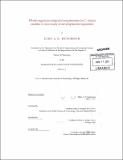Whole-organism integrative expressome for C. elegans enables in silico study of developmental regulation
Author(s)
Hutchison, Luke A. D. (Luke Alexander Daysh), 1976-
DownloadFull printable version (13.64Mb)
Other Contributors
Massachusetts Institute of Technology. Dept. of Electrical Engineering and Computer Science.
Advisor
Isaac S. Kohane and Bonnie A. Berger.
Terms of use
Metadata
Show full item recordAbstract
The C. elegans nematode has been extensively studied as a model organism since the 1970s, and is the only organism for which the complete cell division tree and the genome are both available. These two datasets were integrated with a number of other datasets available at WormBase.org, such as the anatomy ontology, gene expression profiles extracted from 8ooo peer-reviewed papers, and metadata about each gene, to produce the first ever whole-organism, cell-resolution map of gene expression across the entire developmental timeline of the organism, with the goal to find genomic features that regulate cell division and tissue differentiation. Contingency testing was performed to find correlations between thousands of gene attributes (e.g. the presence or absence of a specific 8-mer in the 3' UTR, the CG-content of the sequence upstream of the transcriptional start site, etc.) and thousands of cell attributes (e.g. whether cells that express specific genes die through apoptosis, whether cells become neurons or not, whether cells move in the anterior or posterior direction after division). The resulting database of contingency test scores allow us to quickly ask a large number of biologically-interesting questions, like, "Does the length of introns of expressed genes increase across the developmental timeline?"; "Across what period of development and in which cell types is this specific gene most active?"; "Do regulatory motifs exist that switch on or off genes in whole subtrees of the cell pedigree?"; "Which genes are most strongly implicated in apoptosis?", etc. This whole-organism expressome enables direct and powerful in silico analysis of development.
Description
Thesis (Ph. D.)--Massachusetts Institute of Technology, Dept. of Electrical Engineering and Computer Science, 2011. Cataloged from PDF version of thesis. Includes bibliographical references (p. 117-119).
Date issued
2011Department
Massachusetts Institute of Technology. Department of Electrical Engineering and Computer SciencePublisher
Massachusetts Institute of Technology
Keywords
Electrical Engineering and Computer Science.